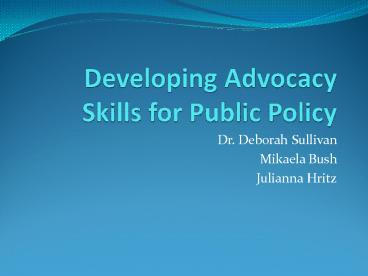Developing Advocacy Skills for Public Policy - PowerPoint PPT Presentation
1 / 17
Title:
Developing Advocacy Skills for Public Policy
Description:
Dr. Deborah Sullivan Mikaela Bush Julianna Hritz Our Goals And Objectives Today Share a process to develop advocacy skills to influence public policy at local, state ... – PowerPoint PPT presentation
Number of Views:230
Avg rating:3.0/5.0
Title: Developing Advocacy Skills for Public Policy
1
Developing Advocacy Skills for Public Policy
- Dr. Deborah Sullivan
- Mikaela Bush
- Julianna Hritz
2
Our Goals And Objectives Today
- Share a process to develop advocacy skills to
influence public policy at local, state and
national levels. - Participants will be able to
- 1. examine their current level of political
participation. - 2. evaluate Public Policy issues in preparation
to advocate on behalf of children and families. - 3. design and implement a program to develop
advocacy skills in others.
3
The Process
- Select a Public Policy topic related to family
well-being. - Prepare a Public Policy Analysis Brief using
AAFCSs Five Is Policy Analysis Organizing
Tool. - Following analysis, choose a course of action
explaining how the choice improves the quality of
life for individuals/families/communities. - Contact the appropriate legislator expressing the
course of action desired, based on the analysis
completed.
4
How a Bill Becomes a Law
http//youtu.be/tyeJ55o3El0
5
Issue-to-Policy Evolution
- In order for a policy to become it must move
from a concern to a new policy
6
Stages of Policy Evolution
- Concern
- Involvement
- Issue
- Alternatives
- Consequences
- Choice
- Implementation
- Evaluation
7
Stage 1 Concern
- Citizens begin by expressing concern
- Example Citizens realize that their community
has no means of transportation of elderly persons - Our Example
- Recent events Sandy Hook
- Class agreed on the controversy
- Recent legislation introduced
8
Stage 2 Involvement
- Example Citizens may become involved in this
issue as individuals or as members of a group
working together to address the transportation
problem. - Our example the class felt this was a current
concern that needed addressed with new
legislation that was being debated in congress.
9
Stage 3 Issue
- Citizens then clarify the issue by defining the
scope of the problem. - Example They may talk with community leaders
and the elderly to further define and clarify the
transportation issue. - Our example we began researching the topic with
the assistance of a reference librarian.
10
Stage 4 Alternatives
- Important step in public policy is to identify
alternatives - Example Citizens can consider alternatives such
as applying for government grants, inviting
private businesses to bid on developing a
transportation system, or organizing volunteers
to donate transportation - Recognize that doing nothing is an alternative
11
Alternatives
- Our example We looked for different points of
view, who agreed/disagreed and why - We investigated groups for and against gun
control - Half of the class researched the pros of gun
control and half of the class researched the cons
12
Stage 5 Consequences
- Explore the consequences
- Example A government grant may help with a
feasibility study or purchase of a van, but then
additional funding sources will be needed. Or,
volunteers may be willing to help in the
beginning of the project, but tire as the project
matures - Our example We considered who was impacted by
this issue and what the implications were
13
Stage 6 Choice
- When all alternatives and their consequences have
been considered, a choice must be made - While the citizen may influence the choice,
she/he does not typically make the choice at this
step - Instead, the citizen indirectly influences policy
makers who make those decisions - Our example For purposes of the paper, consensus
was drawn by the class on the issue
14
Stage 7 Implementation
- The citizens role in implementing the choice is
to learn how to provide input to the policy maker
as implementation procedures are developed - Our example Students decided which side of the
issue they supported and wrote an individual
letter to their legislator with their research
based opinion - Visit from Congressman Bob Gibbs
15
Stage 8 Evaluation
- Example If citizens are happy with the
resolution to the elderly transportation issue,
they move on to other activities - If they are unhappy, they begin the process
again, possibly campaigning to elect new
policymakers as a result of the experience
16
Conclusion of Our Project
- In the end, S. 150 Assault Weapons Ban of 2013
was not passed in the Senate - Since the Sandy Hook Elementary shootings,
Congress has not passed any gun control
legislation - Learning this process provided us with the
confidence and tools to contact our legislators
regarding our concerns on current issues
17
Our Goals And Objectives Today
- Share a process to develop advocacy skills to
influence public policy at local, state and
national levels. - Participants will be able to
- 1. examine their current level of political
participation. - 2. evaluate Public Policy issues in preparation
to advocate on behalf of children and families. - 3. design and implement a program to develop
advocacy skills in others.































